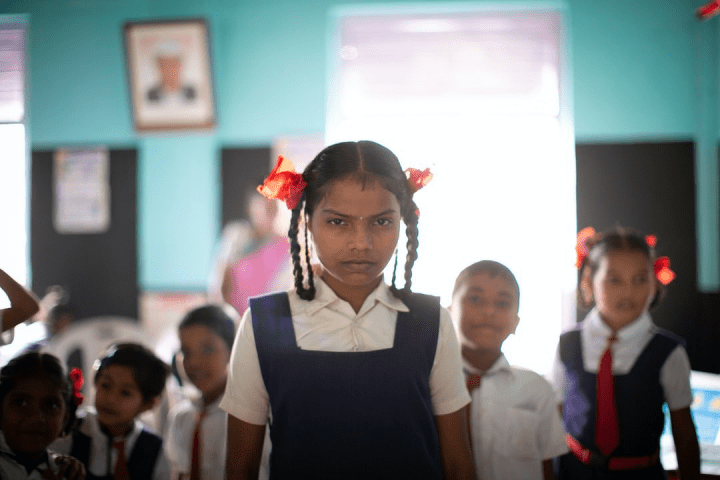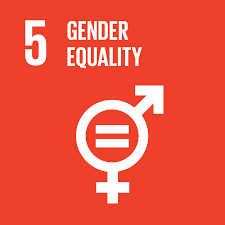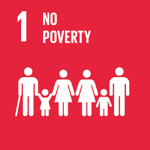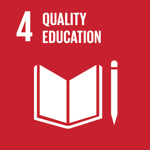Meet Deepa.[i] She was orphaned as a child and she was brought to Mumbai by her aunt, who could not provide more to her than a secure home life and vocational training. Deepa is now the backbone of the household, which includes her mother in law suffering from dementia and her two nearly teenaged daughters. Deepa herself has barely finished school, but she believes strongly in the importance of education. She sends her daughters to one of the best schools in the area, paying almost INR 25k per semester. The girls take the school bus, because she does not want them to feel left out. She encourages them to go for art classes, play basketball, and read books. She would love for her daughters to achieve a happy and successful life. Therefore, she is desperate to understand what career opportunities might exist for her daughters beyond what she has seen in her chawl: cooking, beauty services, and cleaning homes. She would like to offer them a better chance to live the life they want through successful careers. Merely having access to the internet has not been sufficient to provide them with the necessary information – most of which is often ‘soft’ rather than ‘hard’ data. How can she help her daughters make the right decisions? Will they be able to reach their potential and have a better life?
The story of Deepa and her daughters is exemplary of many other women and girls in India, where inequality is a major issue. In the absence of cultural stimulus and role models, girls often end up in the same pattern as their mothers did before them.
India’s population counts more than 1.35 billion individuals, of which around 48% is female. The employment to population ratio for women aged more than 15 years old is only around 19.73%.[ii] Despite a rapid economic growth, less than a quarter of women aged more than 15 years old participate in the work force and this rate is declining. Also, women in rural areas in India are leaving the workforce at a faster rate than urban women.[iii] More than that, women in rural parts of India often face stringent living conditions dictating their life and work choices. They do not have the flexibility to choose between different career paths, are sometimes not aware of such opportunities or believe that they are out of reach.
The issue of gender inequality goes beyond human rights, it also leaves a massive economic potential untapped. As mentioned, less than a quarter of working age women in India are employed. This issue hinders the country’s growth as a whole, as India could boost its GDP by $0.7 trillion by 2025 (16% of the business-as-usual level) by improving gender equality on the labor market.[iv] Globally, India’s economy would have the highest relative boost in GDP from women participation in the market economy on a similar basis to men. Thereby closing the current gaps in labour-force participation rates, hours worked, and representation in equally productive sectors. This economic potential in India is not achievable without addressing the gender gaps in the society.
Even amongst the student population in India, regardless of gender, a vast majority of them (around 93%) are only aware of the 7 ‘typical’ career options, i.e. law, engineering, medicine, accounts and finance, design, computer science and IT, and management, although there are more than 250 different types of career options available in India.[v] This ignorance of career options in India stems from a lack of counselling support at all levels of education and bridging this gap is paramount for the future generations and the growth of the country.
We believe there is a role to be played by both public policy and business to close the gender gap in India. Key points are improving education, lowering barriers for job creation, providing access to finance, improving infrastructure for domestic tasks such as childcare, and reshaping attitudes in society about women working. Another way to empower women in the workforce would be to include gender equality as a core theme in social corporate responsibility; it could take different forms, including financial support for girls educational programmes, promoting positive messages regarding female career achievements and successful women acting as role models for girls in the form of a mentorship programme.[vi] In fact, we believe that these young women can be empowered to make better decisions by exposure to alternative career options and access to strong female role models.
Our Product – ConnectHer:
ConnectHer is a woman-to-woman platform that connects underprivileged young women (between the ages of 12-21) from both urban and rural settings to professional women from the more privileged parts of society to serve as inspiring and successful role models, and provide advice on careers, leadership, personal, professional, and medical help. This platform can create a trusted community where women help women succeed in their careers, and also become more independent. ConnectHer aims to become the low-cost LinkedIn and mentorship platform designed to reach those that are not well-versed with business English and other prerequisites required to network on LinkedIn. We plan to focus on India as our first market and then expand to other countries.

https://unsplash.com/photos/GqNqFMh3OoU
Context:
Young women in urban-poor communities will be able to connect through a basic platform to ask questions they feel awkward to ask other women in their family and society, or when the women they know do not have answers. Questions around career options, law and regulations, physical and mental health can be safely asked through a confidential platform to women who are successful in these spheres of work.
Mobile phone penetration is very high in the Indian market, with more than a third of the country across socio-economic spectrum owning at least a basic smartphone with Whatsapp.[vii] This ensures that there is a sizable ‘market’ of women who could use and benefit from our platform.
With English and several major Indian languages being supported on smartphone keyboards, we foresee that communication between the mentors and the mentees would be fairly straightforward. As India is rich in numerous regional languages, we hope we will be able to find mentors that can speak the mentee’s preferred language/dialect, thus bringing different parts of society closer.
We estimate a theoretical target market of 1.75 million young women based on the following data points and assumptions. The population of the top 6 cities of India being 70 million, urban poverty rates of 25%, assuming 50% women, and 20% of these as women between the age of 12-21.[viii]

https://unsplash.com/photos/nWpTGnP_jWE
Minimum Viable Product:
We envision to launch an MVP that will function as follows:
- Selection of one city to launch to facilitate processes.
- A website collects signup information from interested mentors – ideally these are professional women between the ages of 25-45.
- Mentors are asked to provide information on languages spoken, location, industry of work etc.
- A rigorous verification process is conducted – including identity proof, background checks, requesting LinkedIn recommendations etc.
- The selected mentors have to go through a self-learning module around coaching and counselling.

https://unsplash.com/photos/jhu22nvxxCw
- A potential mentee messages a whatsapp account indicating interest to sign up.
- The whatsapp account requests the following information: languages spoken, location, education level, age, interest areas (if any).
- Alternatively, the mentee can also call a phone number and we will take their request.
- At the backend, the platform matches the mentee with a suitable mentor based on these factors.
- The mentor and the mentee are connected through a whatsapp group chat.
Business Model:
Our revenue streams will come primarily from recruiters posting jobs on the platform, and then from highly vetted advertisements, as well as from partnerships with major companies as part of their CSR initiatives. Companies looking to hire employees will be able to use our platform once it develops into an app-based platform to advertise job offers and hire suitable candidates.
ConnectHer will be free to use for both mentors and mentees. Once the platform attracts a certain quantity of users and can be upgraded to an app, we will offer a premium version whereby recruiters will be able to contact users directly, similar to LinkedIn.
Another source of potential revenues would be through partnerships with phone companies. In fact, a large number of Indian women do not have a cellphone on their own and when they do, do not connect to the internet. This could be a huge source of revenues for phone companies in the coming years and our platform would act as an incentive for women to get their own phone. The goal is that our platform becomes self-funded relatively quickly.
Challenges Foreseen:
- Safety:
- Safety is likely to be the biggest risk and concern with the platform. As the mentees will all be young women from underprivileged backgrounds, there is a risk of malicious actors exploiting the platform to gain access to the mentees.
- In order to ensure safety – the following mitigation steps will be undertaken:
- All mentors need to go through a stringent background check and verification process. They will need to share a photo of their ID and a proof of residence.
- Mentees will also have to go through an identity check and verify that the mobile phone number belongs to them/a trusted family member.
- Upon being matched, the mentees identity will be anonymised for the mentor. After a certain amount of time, the mentee will be given the option to share their identity with their mentor – provided they like the match and trust the mentor.
- Mentors and mentees are encouraged to communicate through the platform and not through external means. Communication will also be anonymously monitored through software for ‘keywords’ that trigger suspicion.
- Scalability:
- Since each mentor would typically only talk to one or two mentees at a time, and the goal of the platform is to build long term mentor-mentee relationships, it becomes critical to have a constant stream of new mentors and mentees signing up and using the platform. Therefore, the key lever to focus on would be marketing and brand awareness – both by referral / word-of-mouth, and through paid advertisements.
- Technically, the platform is expected to be very light and will likely not have astronomical server costs as it scales.
- The key challenge will be the background check and verification process. Most parts of this process would need to be automated in order to scale. Lessons can be learned from the way mobile wallets or banks do it, for example, the process used by ‘Revolut’ to verify IDs.
- Incentive alignment:
- Mentees have a strong incentive to join the platform as it provides them access to information and opens doors.
- Mentors who join the platform are typically women who want to volunteer for causes but might not have the time to physically do this on site. The platform provides them a convenient option of adding value from their homes and of contributing to womens’ lives in the long term.
- Recruiters benefit from a talent pool that is eager to prove themselves and also has training and refinement through contact with mentors – thus above the average.
Robust Product Vision:
In the long run, we envision the platform to become app-based, for the following reasons:
- An app based platform will make it easier to control communications that happen directly through the platform. It also provides for more secure communication channels compared to whatsapp.
- The app will also have an appointment scheduling feature that enables mentors and mentees to connect easily without having to go back and forth to find a time that works.
- The app can also contain discussion boards based on topic of interest – these boards can serve as rich sources of information for new mentees who might want to learn about multiple topics before requesting to speak to a mentor who has experience in that sector.
- Job listings can also be hosted on the platform – this would provide more value to recruiters who can then review and screen candidates through it directly, much like LinkedIn.
Going forward:
There has been a recent rise in women-led communities in the fields of Technology, STEM, Medicine etc., for example “Tech for Girls”, “Lean In”, “Million Women Mentors”, however, our vision is to bring such a platform to underprivileged communities in India, where the women are not necessarily literate and need mentorship support.
Targeted SDG goals:
The primary SDG goal targeted by our solution is #5 Gender Equality. Specifically, we seek to address the following target:
5.b Enhance the use of enabling technology, in particular information and communications technology, to promote the empowerment of women.

Other related goals that our project relates to include #1 No Poverty and #4 Quality Education.


The specific targets are the following:
1.4 By 2030, ensure that all men and women, in particular the poor and the vulnerable, have equal rights to economic resources, as well as access to basic services, ownership and control over land and other forms of property, inheritance, natural resources, appropriate new technology and financial services, including microfinance
4.4 By 2030, substantially increase the number of youth and adults who have relevant skills, including technical and vocational skills, for employment, decent jobs and entrepreneurship
4.5 By 2030, eliminate gender disparities in education and ensure equal access to all levels of education and vocational training for the vulnerable, including persons with disabilities, indigenous peoples and children in vulnerable situations
Why is our project critical?
Gender equality is not only a basic human right, but it is also crucial to India’s future growth.[ix] It is proven that empowering women and girls supports economic growth and development of a country.[x] In addition, empowering women in India allows to fight against sexual violence and exploitation. Most of the work done by women in India is not paid still today, and it is often informal and unprotected; in addition, around half of the women do not have access to the financial system, do not hold a bank account in their name nor have assets of their own.[xi]
How will ConnectHer promote women’s empowerment in India?
By connecting under-privileged women to privileged women in the country, ConnectHer will help bridging the gap between skills and jobs and give access to decent work to women. The platform will enable under-privileged women to reach out to experienced and successful women acting as mentors to assist them in different areas of their lives. Generally, under-privileged women in India do not have access to career counselling nor to information regarding opportunities they could pursue. Hence, they are not aware that they could have successful careers other than traditional paths such as cooking, beauty services or cleaning homes. The idea is to provide them with a real choice between different career opportunities and with support in several aspects of their life through that journey.
Through our platform, we hope to provide free access to information to hundreds of underprivileged women with a view of widening their knowledge of career opportunities and providing assistance where needed in order for them to seek their dreams. Face-to-face meetings could also be arranged. To overcome the barrier of reaching out to unknown mentors through technology, we intend to demonstrate the concept of mentorship to interested women and to share engaging mentor life stories. Also, the pairing process will be mindful of origins, backgrounds and locations, to ensure that underprivileged women are able to connect to their mentors and be inspired by their experience.
Finally, our platform can also be leveraged to educate the industry on the benefits of gender equality in the workforce and to identify role models to grow the community.[xii] Women highly ranked in companies could, in addition to their role as mentors on the platform, pledge their support towards gender equality, lead other organisations in their sector to implement gender equality policies and improve the brand value for organisations supporting women in their workforce.[xiii]
[i] This story is from personal experience. The name and image of the real person has been modified to protect her identity. Above photo from: https://unsplash.com/photos/MkPINODL-Tw.
[ii] https://tradingeconomics.com/india/population-female-percent-of-total-wb-data.html
[iii] https://www.catalyst.org/research/women-in-the-workforce-india/
[iv] McKinsey Global Institute, The power of parity; Advancing women’s equality in India, November 2015
[v] India Today, 93% Indian students aware of just seven career options: What are parents doing wrong?, 2019.
[vi] McKinsey Global Institute, The power of parity; Advancing women’s equality in India, November 2015.
[vii] https://www.statista.com/statistics/280914/monthly-active-whatsapp-users-in-india/
[viii] http://www.citypopulation.de/India-Agglo.html
[ix]https://www.undp.org/content/undp/en/home/sustainable-development-goals/goal-5-gender-equality.html
[x]https://www.undp.org/content/undp/en/home/sustainable-development-goals/goal-5-gender-equality.html
[xi]https://in.one.un.org/unibf/gender-equality/
